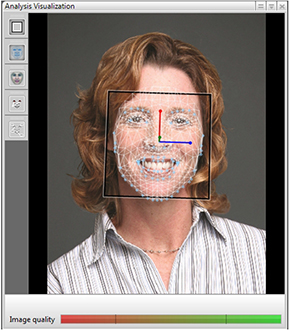FaceReader
Model: NLFACE

FaceReader is the most advanced tool for automatic analysis of facial expressions, providing users with an objective assessment of a persons emotion. It automatically analyzes the expressions: happy, sad, angry, surprised, scared, disgusted, contempt, and neutral.
FaceReader 8.1 is the premier professional software for automatic analysis of 6 basic facial expressions (happy, sad, scared, disgusted, surprised, and angry), as well as classifying neutral and now contempt. FaceReader 8.1 also provides gaze direction, head orientation, and person characteristics, such as gender and age. Detailed analysis of facial action units is also available. The software immediately analyzes your data (live, video, or still images) saving valuable time. Its available as software, but also as an online application. Read on to learn more about the new features version 8.1 offers you.
- FaceReader is the complete facial expression analysis software.
- Over 300 sites worldwide make use of FaceReader.
- More than 10.000 manually annotated images used for training the software.
- Improved East-Asian model trained with over 4.000 manually annotated images.
- Accurate modeling of the face by describing 500 key points.
- Versatile system including OEM possibilities and an API.
- Carry out your project in an efficient way and increase accuracy and reliability.
- Objectivity in observations.
FaceReader classifies:
- Happy
- Sad
- Scared
- Disgusted
- Surprised
- Angry
- Neutral
- Contempt
Besides these six basic facial expressions and neutral, FaceReader 6 now also automatically classifies contempt. Contempt is defined as the feeling that a person or a thing is beneath consideration, worthless, or deserving scorn and therefore seen as a negative emotion. Measuring it in addition to other facial expressions can add great value to your research.
FaceReader works in three steps:
- Face finding an accurate position of the face is found.
- Face modeling the Active Appearance Model is used to synchronize an artificial face model, which describes the location of over 500 key points as well as the texture of the face.
- Face classification output is pr esented as six basic expressions, contempt, and one neutral state.
There are multiple face models available in FaceReader. In addition to the general model which works well under most circumstances for most people, there are models for East Asian people, elderly, and children. In order to improve the East-Asian model, classifiers for expression analyses of East-Asian people were newly trained with over 4.000 images!
Circumplex model
The circumplex model of affect describes the distribution of emotions in a 2D circular space, containing arousal and valence dimensions. FaceReader offers a real-time representation of this model with the horizontal axis representing the valence dimension (pleasant - unpleasant) and the vertical axis representing the arousal dimension (active - inactive). Facial expressions automatically measured with FaceReader, can be represented at any level of valence and arousal. Circumplex models (Russel 1980) are commonly used to assess liking in marketing, consumer science, and psychology.
Action Unit analysis
FaceReader now analyzes a selection of 20 commonly used Action Units, such as raising of cheeks, wrinkling of nose, dimpling, and lip tightening. This module offers you valuable information in a minimal amount of time, particularly when analyzing a large amount of video recordings.
Complete solution
Intuitive and easy to operate, the newly enhanced Project Analysis Module can be used for advanced analysis and reporting. Version 6 allows you to compare responses to different video stimuli in one view, offering faster insights into the effects of stimuli. Add the video stimuli of your choice, with or without sound. This release will have great impact on facial expression research with features such as grouping participants, reporting multiple stimuli at once, and creating templates. FaceReader 6 also allows you to add independent variables such as educational level or previous knowledge level which allows you to group your participants (i.e. female with high education level). As a result, the software enables you to work effectively and efficiently.

